语言学精要
语言学概论
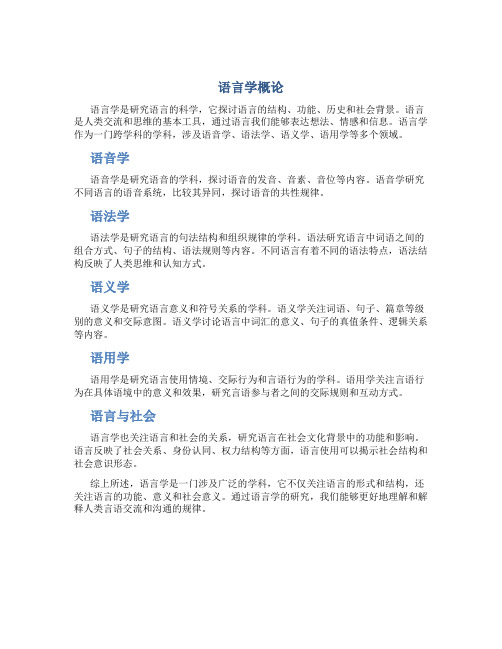
语言学概论
语言学是研究语言的科学,它探讨语言的结构、功能、历史和社会背景。
语言是人类交流和思维的基本工具,通过语言我们能够表达想法、情感和信息。
语言学作为一门跨学科的学科,涉及语音学、语法学、语义学、语用学等多个领域。
语音学
语音学是研究语音的学科,探讨语音的发音、音素、音位等内容。
语音学研究不同语言的语音系统,比较其异同,探讨语音的共性规律。
语法学
语法学是研究语言的句法结构和组织规律的学科。
语法研究语言中词语之间的组合方式、句子的结构、语法规则等内容。
不同语言有着不同的语法特点,语法结构反映了人类思维和认知方式。
语义学
语义学是研究语言意义和符号关系的学科。
语义学关注词语、句子、篇章等级别的意义和交际意图。
语义学讨论语言中词汇的意义、句子的真值条件、逻辑关系等内容。
语用学
语用学是研究语言使用情境、交际行为和言语行为的学科。
语用学关注言语行为在具体语境中的意义和效果,研究言语参与者之间的交际规则和互动方式。
语言与社会
语言学也关注语言和社会的关系,研究语言在社会文化背景中的功能和影响。
语言反映了社会关系、身份认同、权力结构等方面,语言使用可以揭示社会结构和社会意识形态。
综上所述,语言学是一门涉及广泛的学科,它不仅关注语言的形式和结构,还关注语言的功能、意义和社会意义。
通过语言学的研究,我们能够更好地理解和解释人类言语交流和沟通的规律。
Pascal语言精要
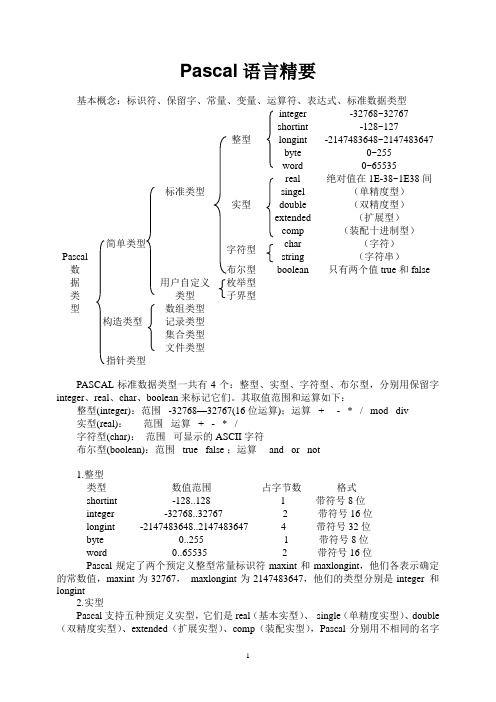
Pascal 语言精要基本概念:标识符、保留字、常量、变量、运算符、表达式、标准数据类型 Pascal 数 据 类 型简单类型标准类型 整型 integer -32768~32767 shortint -128~127 longint -2147483648~2147483647 byte 0~255 word 0~65535 实型 real 绝对值在1E-38~1E38间 singel (单精度型) double (双精度型) extended (扩展型) comp (装配十进制型) 字符型char (字符)string (字符串) boolean 只有两个值true 和false 用户自定义类型 枚举型 子界型 构造类型 数组类型记录类型集合类型 文件类型指针类型PASCAL 标准数据类型一共有4个:整型、实型、字符型、布尔型,分别用保留字integer 、real 、char 、boolean 来标记它们。
其取值范围和运算如下:整型(integer):范围 -32768—32767(16位运算);运算 + - * / mod div 实型(real): 范围 运算 + - * /字符型(char): 范围 可显示的ASCII 字符布尔型(boolean):范围 true false ;运算 and or not1.整型类型 数值范围 占字节数 格式 shortint -128..128 1 带符号8位 integer -32768..32767 2 带符号16位 longint -2147483648..2147483647 4 带符号32位 byte 0..255 1 带符号8位 word 0..65535 2 带符号16位Pascal 规定了两个预定义整型常量标识符maxint 和maxlongint ,他们各表示确定的常数值,maxint 为32767, maxlongint 为2147483647,他们的类型分别是integer 和longint2.实型Pascal 支持五种预定义实型,它们是real (基本实型)、 single (单精度实型)、double (双精度实型)、extended (扩展实型)、comp (装配实型),Pascal 分别用不相同的名字作为他们的标识符。
Pascal精要

在 Pascal 中,注释括在大括号中或带星号的圆括号中。Delphi 也认可 C++ 风格的注释, 即把注释放在双斜线后。例如
{this is a comment} (* this is another comment *) // this is a comment up to the end of the line
关于空格和语句分行的使用没有既定的规则,以下是几点经验:
• Delphi 代码编辑器中有一条竖线叫右边线(Right Margin),你可以把右边线设置在 60 或 70 个字符处。如果以这条线为基准,代码不超过这条界限,那么打印到纸上的代码 看起来会很好看。否则,打印时长语句会被随意分行,甚至在一个词的中间断开。
图 2.2 代码模板选项
代码模板可以定制,就是你可以修改已有的模板也可以添加自己常用的代码段。用代码模 板输入的代码文本中通常会出现‘|’字符,它表示输入模板代码后光标应跳到的位置,就是说你 应该从这个光标位置开始输入,写完这句代码。
编程语句
标识符一经定义 ,你就可以在语句及组成语句的表达式中使用它们。Pascal 提供了许多语 句和表达式,首先来看看关键字、表达式和运算符。
提出以上代码编写格式只是向你建个议而已,这样代码能更加易读,其实代码格式并不影 响编译结果。在本书的例子和代码段中我始终坚持使用上述代码风格,Delphi 中的源代码、手 册和帮助例子均采用了相似的格式化风格。
突出 Pascal 元素
为了使 Pascal 代码更易读写,Delphi 编辑器中增加了 Pascal 元素的色彩设置功能,也就 是编辑器会用不同的颜色表示不同的 Pascal 元素。缺省情况下,关键字以粗体表示,字符串和 注释用蓝色表示(并且常常是斜体)。
语言学概论-(完整版)下半部分
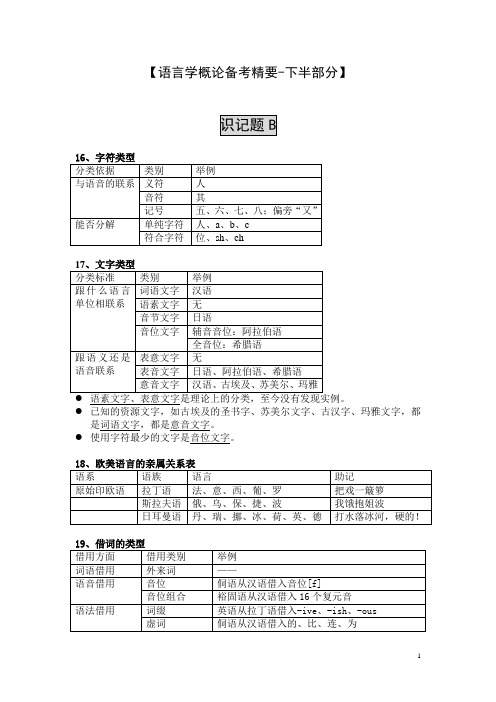
【语言学概论备考精要-下半部分】语素文字、表意文字是理论上的分类,至今没有发现实例。
●已知的资源文字,如古埃及的圣书字、苏美尔文字、古汉字、玛雅文字,都是词语文字,都是意音文字。
●使用字符最少的文字是音位文字。
由意音文字换用表音文字,属于文字类型改革。
文字起源于图画和契刻。
汉字字体演变经历了甲骨文、金文、小篆、隶书、楷书几个阶段。
文字发展三阶段论认为,文字经历的从低级到高级的发展阶段是:象形文字或表意文字阶段、音节文字阶段、音位文字阶段。
人类有声语言的产生大约是在旧石器时代晚期,也就是晚期智人时期。
语言发展演变的特点是:渐变性、不平衡性。
世界各语言按亲属关系可分为九个语系:汉藏语系、印欧语系、乌拉尔语系、阿尔泰语系、闪含语系、高加索语系、达罗昆荼语系、马来-玻利尼西亚语系、南亚语系。
语言的谱系分类由高到底依次为:语系、语族、语支、语群。
语言混合的形式有洋泾浜语、克里奥耳语。
语言接触的结果包括:语言成分的借用与吸收、双语现象、语言的转用、语言的混合。
语言转用的社会条件:民族融合,经济、文化水平和人口数量。
关于语言起源的说法有:神授说、人创说、摹声说、社会契约说。
语言起源必须具备的三个条件:心理条件、生理条件、社会条件。
对大脑的研究催生了神经病理语言学,包括神经语言学、病理语言学两个分支。
人类学习语言的临界期是十二至十三岁的青春期。
儿童语言获得的过程分为6个阶段:非自控阶段、咿呀学语阶段、单词阶段、双词阶段、简单句阶段、复杂句阶段。
儿童语言获得的理论包括:模仿说、强化说、天赋说、认知说。
关于大脑构造与人的语言能力关系的研究成果包括:单侧化现象研究、左半球分区研究、语言遗传机制研究、语言功能的临界期研究、大脑构造的独特性研究。
语言在思维认知活动中的作用:帮助完成认知过程、储存认知成果、改造认知能力。
《永乐大典》是世界上第一部综合性的百科知识辞典。
《现代汉语词典》、《新英汉词典》是典型的语言词典。
《词源》是语言词典、语文词典、历史词典。
幼儿园领域课程指导丛书 幼儿园语言领域教育精要关键经验与

目录分析
目录分析
《幼儿园领域课程指导丛书:幼儿园语言领域教育精要关键经验与》是作者刘宝根、唐淑华、孔 蓉萍和李云根据幼儿园语言领域教育的特点和要求,结合幼儿园教育实践编写的一本指导用书。 本书主要介绍了幼儿园语言领域教育的基本概念、目标、内容、方法、活动设计等方面的内容, 旨在帮助幼儿园教师更好地培养幼儿的语言能力。 领域概述幼儿园语言领域教育是指幼儿在口头语言、书面语言和早期阅读方面的发展。本书分析 了幼儿园语言领域教育的重难点,提出了一些解决思路,如注重幼儿的主动学习、创设良好的语 言环境、提供多样化的语言输入和输出机会等。 关键经验本书总结了一些关键经验,包括教育手段、教学方法、活动设计等,以帮助教师更好地 了解如何在教学活动中培养幼儿的语言能力。
阅读感受
作者对幼儿语言学习的特点进行了全面分析,提出了一系列针对性的教育建议,例如:鼓励幼儿 多听、多说、多读、多写,培养他们的语感和表达能力;创设良好的语言交往环境,帮助幼儿建 立自信心和良好的人际关系;利用直观感知的教学方式,引导幼儿认识世界,提高他们的认知能 力。
书中还提供了许多实用、可操作的活动案例和教育教学策略,例如:通过观察花草树木、动手做 手工等活动,丰富幼儿的生活内容和认知经验;利用文学作品、角色扮演等形式,激发幼儿的语 言兴趣和创造力;建立家园合作机制,共同促进幼儿的语言发展。这些活动和策略不仅有助于提 高幼儿的语言能力,也有利于培养幼儿的观察力、思维力和创造力等多方面能力。
幼儿园领域课程指导丛书:幼 儿园语言领域教育精要关键经
验与
读书笔记
01 思维导图
03 精彩摘录 05 目录分析
目录
02 内容摘要 04 阅读感受 06 作者简介
思维导图
本书关键字分析思维导图
语言学概论 课程的基本要求

语言学概论课程的基本要求
1.理论知识掌握:
-学生应系统地学习和理解语言学的基础概念、基本原理和主要分支领域,如语音学(音系学)、形态学、句法学、语义学、语用学等。
-理解语言的性质、结构规律以及语言的发展演变过程。
2.研究方法掌握:
-掌握语言学研究的基本方法,包括定性分析与定量分析相结合的研究手段,共时研究与历时研究的结合应用。
-学会运用科学的方法分析具体的语言现象和问题,能够独立完成简单的语言学研究任务。
3.学科关联性认知:
-认识到语言与社会、文化、思维之间的密切联系,理解语言在人类生活和交流中的作用。
-将所学的语言学理论知识应用于实际语言现象的解释和现代汉语、古代汉语以及其他具体语言的学习中。
4.跨学科能力培养:
-提高学生对其他相关学科如心理学、社会学、人类学、计算机科学等与语言学交叉领域的认识和应用能力。
-能够灵活运用语言学理论解决外语学习、语言教学、翻译实践等领域的问题。
5.自主学习与实践探索:
-通过阅读文献、参与讨论、撰写读书报告等形式,锻炼学生的自主学习能力和独立思考能力。
-进行实地调查和社会实践活动,增强将理论知识与社会实践相结合的能力。
6.批判性思维与创新能力:
-培养学生对语言现象进行批判性分析的能力,并鼓励他们在已有理论框架下进行创新性思考。
幼儿园语言领域教育精要关键经验与活动指导第一章节
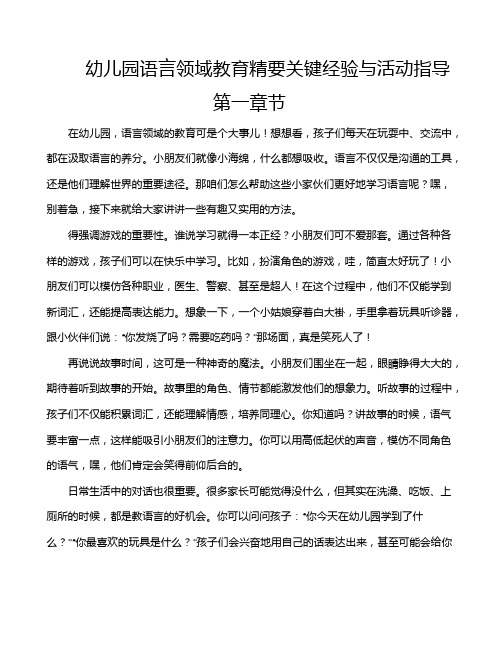
幼儿园语言领域教育精要关键经验与活动指导第一章节在幼儿园,语言领域的教育可是个大事儿!想想看,孩子们每天在玩耍中、交流中,都在汲取语言的养分。
小朋友们就像小海绵,什么都想吸收。
语言不仅仅是沟通的工具,还是他们理解世界的重要途径。
那咱们怎么帮助这些小家伙们更好地学习语言呢?嘿,别着急,接下来就给大家讲讲一些有趣又实用的方法。
得强调游戏的重要性。
谁说学习就得一本正经?小朋友们可不爱那套。
通过各种各样的游戏,孩子们可以在快乐中学习。
比如,扮演角色的游戏,哇,简直太好玩了!小朋友们可以模仿各种职业,医生、警察、甚至是超人!在这个过程中,他们不仅能学到新词汇,还能提高表达能力。
想象一下,一个小姑娘穿着白大褂,手里拿着玩具听诊器,跟小伙伴们说:“你发烧了吗?需要吃药吗?”那场面,真是笑死人了!再说说故事时间,这可是一种神奇的魔法。
小朋友们围坐在一起,眼睛睁得大大的,期待着听到故事的开始。
故事里的角色、情节都能激发他们的想象力。
听故事的过程中,孩子们不仅能积累词汇,还能理解情感,培养同理心。
你知道吗?讲故事的时候,语气要丰富一点,这样能吸引小朋友们的注意力。
你可以用高低起伏的声音,模仿不同角色的语气,嘿,他们肯定会笑得前仰后合的。
日常生活中的对话也很重要。
很多家长可能觉得没什么,但其实在洗澡、吃饭、上厕所的时候,都是教语言的好机会。
你可以问问孩子:“你今天在幼儿园学到了什么?”“你最喜欢的玩具是什么?”孩子们会兴奋地用自己的话表达出来,甚至可能会给你讲个小故事。
这个时候,家长的耐心倾听是关键,千万不要打断他们,给他们空间去表达自己的想法。
再来谈谈唱歌,谁不喜欢呢?小朋友们总是喜欢跟着旋律摇摆,唱出他们的小歌声。
通过唱歌,他们不仅能学习到新的词汇和句子,还能在轻松的氛围中增强记忆力。
那些简单的儿歌、童谣,节奏感强、重复性高,非常适合小朋友。
就算唱得走音,没关系,最重要的是他们在享受这个过程。
唱歌的时候,家长也可以加入进来,和孩子们一起唱,欢乐的气氛让语言学习变得更有趣。
形态分析精要青木
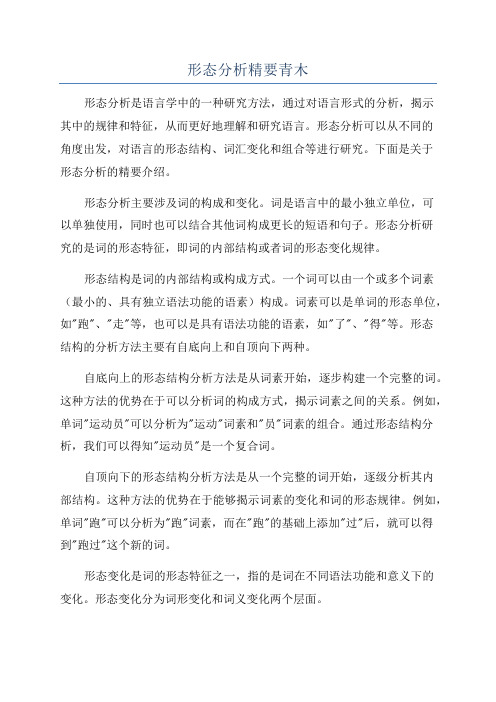
形态分析精要青木形态分析是语言学中的一种研究方法,通过对语言形式的分析,揭示其中的规律和特征,从而更好地理解和研究语言。
形态分析可以从不同的角度出发,对语言的形态结构、词汇变化和组合等进行研究。
下面是关于形态分析的精要介绍。
形态分析主要涉及词的构成和变化。
词是语言中的最小独立单位,可以单独使用,同时也可以结合其他词构成更长的短语和句子。
形态分析研究的是词的形态特征,即词的内部结构或者词的形态变化规律。
形态结构是词的内部结构或构成方式。
一个词可以由一个或多个词素(最小的、具有独立语法功能的语素)构成。
词素可以是单词的形态单位,如"跑"、"走"等,也可以是具有语法功能的语素,如"了"、"得"等。
形态结构的分析方法主要有自底向上和自顶向下两种。
自底向上的形态结构分析方法是从词素开始,逐步构建一个完整的词。
这种方法的优势在于可以分析词的构成方式,揭示词素之间的关系。
例如,单词"运动员"可以分析为"运动"词素和"员"词素的组合。
通过形态结构分析,我们可以得知"运动员"是一个复合词。
自顶向下的形态结构分析方法是从一个完整的词开始,逐级分析其内部结构。
这种方法的优势在于能够揭示词素的变化和词的形态规律。
例如,单词"跑"可以分析为"跑"词素,而在"跑"的基础上添加"过"后,就可以得到"跑过"这个新的词。
形态变化是词的形态特征之一,指的是词在不同语法功能和意义下的变化。
形态变化分为词形变化和词义变化两个层面。
词形变化是指词的形态结构在不同语法功能或语义下的变化。
这种变化可以通过词缀的添加或改变来实现。
例如,动词"run"通过添加过去时词缀"-ed"变成过去时形式"ran"。
语言学概论——精选推荐

语言学概论教学大纲【说明】1、“语言学概论”是高等师范院校汉语言文学专业的一门基础理论课。
本课的目的和任务是阐述有关语言学的基础理论和基础知识,揭示语言演变发展的基本规律,介绍语言学研究领域的基本研究方法与新成果。
使学生能够初步树立科学的语言观,掌握语言学的基本概念,具备一定的分析、解释语言事实和语言现象的能力,为学生今后从事语文教学或进一步深造打下一定的理论基础。
2、本课教材的选用应遵循科学、精要、实用的原则。
目前我院中文系所使用的教材是北京大学中文系教材。
这本教材的优点是立足于汉语看世界语言的发展规律,符合中文系学生的特点。
而且这本教材是北大两位知名学者编写,有着集科学性、逻辑性、实用性、通俗性于一体的特点,是经过长时间检验的,在全国范围内最受欢迎的语言学教材之一。
3、本课的教学方法应以讲解为主,辅之以适当的讨论与练习。
在一些曾经有过争议或至今仍有分歧的问题下,应鼓励学生自主探索,倡导学生向专家质疑,培养学生独立分析问题解决问题的能力。
4、本课程讲授一学期,共36学时。
【本文】绪论语言学发展历程简介教学目的:本章的教学目的是让学生初步了解“语言学概论”这门课程的研究对象、研究目的和研究方法,并着重了解语言学的历史发展,这有利于学生站在宏观的角度对语言学作一个全面的了解,为下面的学习奠定一定的方法基础。
内容要点:一、语言学是专门研究语言的科学。
二、个别语言学与普通语言学;语言学概论是普通语言学的入门书。
三、语言学的发展历程:1、神话传说时期2、语文学时期3、语言学时期(1)历史比较语言学(2)结构主义语言学(3)转换生成语言学如时间允许,可以在介绍社会语言学、功能语言学、心理语言学、模糊语言学等边缘交叉学科,以开阔学生的视野。
教学方法:以讲解为主教学手段:常规教学手段授课时数:4课时作业与思考:1、历史比较语言学、结构主义语言学、转换生成语言学的代表人物及其主要观点、方法、主要代表作。
2、为什么说历史比较语言学是语言学时期诞生的标志?3、思考题:为什么中国古代的语文学研究和西方古代的语文学研究走上了完全不同的发展道路?第一章语言的社会功能教学目的:对语言从社会功能的角度作一个宏观的、全面的阐释,使学生掌握最基本的语言理论,并能理解和运用这些理论。
幼儿园语言领域教育精要关键经验与活动指导
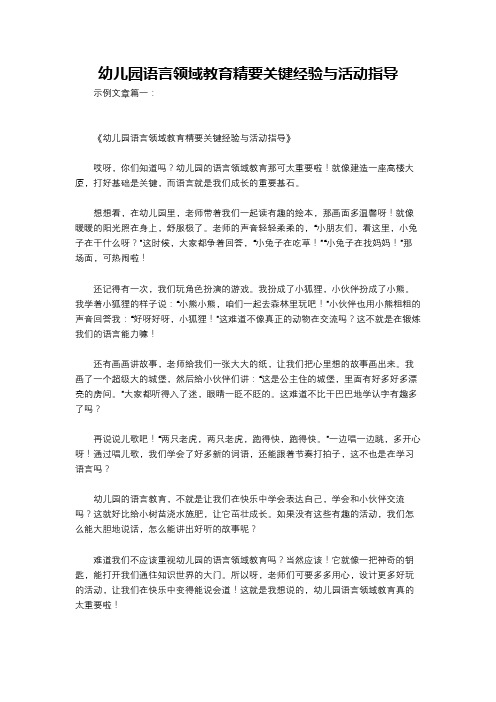
幼儿园语言领域教育精要关键经验与活动指导示例文章篇一:《幼儿园语言领域教育精要关键经验与活动指导》哎呀,你们知道吗?幼儿园的语言领域教育那可太重要啦!就像建造一座高楼大厦,打好基础是关键,而语言就是我们成长的重要基石。
想想看,在幼儿园里,老师带着我们一起读有趣的绘本,那画面多温馨呀!就像暖暖的阳光照在身上,舒服极了。
老师的声音轻轻柔柔的,“小朋友们,看这里,小兔子在干什么呀?”这时候,大家都争着回答,“小兔子在吃草!”“小兔子在找妈妈!”那场面,可热闹啦!还记得有一次,我们玩角色扮演的游戏。
我扮成了小狐狸,小伙伴扮成了小熊。
我学着小狐狸的样子说:“小熊小熊,咱们一起去森林里玩吧!”小伙伴也用小熊粗粗的声音回答我:“好呀好呀,小狐狸!”这难道不像真正的动物在交流吗?这不就是在锻炼我们的语言能力嘛!还有画画讲故事,老师给我们一张大大的纸,让我们把心里想的故事画出来。
我画了一个超级大的城堡,然后给小伙伴们讲:“这是公主住的城堡,里面有好多好多漂亮的房间。
”大家都听得入了迷,眼睛一眨不眨的。
这难道不比干巴巴地学认字有趣多了吗?再说说儿歌吧!“两只老虎,两只老虎,跑得快,跑得快。
”一边唱一边跳,多开心呀!通过唱儿歌,我们学会了好多新的词语,还能跟着节奏打拍子,这不也是在学习语言吗?幼儿园的语言教育,不就是让我们在快乐中学会表达自己,学会和小伙伴交流吗?这就好比给小树苗浇水施肥,让它茁壮成长。
如果没有这些有趣的活动,我们怎么能大胆地说话,怎么能讲出好听的故事呢?难道我们不应该重视幼儿园的语言领域教育吗?当然应该!它就像一把神奇的钥匙,能打开我们通往知识世界的大门。
所以呀,老师们可要多多用心,设计更多好玩的活动,让我们在快乐中变得能说会道!这就是我想说的,幼儿园语言领域教育真的太重要啦!示例文章篇二:《幼儿园语言领域教育精要关键经验与活动指导》哎呀,你知道吗?幼儿园的语言领域教育那可真是超级重要!就像建造高楼大厦,语言就是那坚实的地基。
中高级口译口试备考精要

中高级口译口试备考精要口译是一门需要高度专业素养和出色语言能力的技能。
为了在中高级口译口试中取得好成绩,备考是必不可少的。
本文将为大家提供一些备考的精要,帮助大家更好地应对口译口试。
备考口译口试的第一步是熟悉考试内容和要求。
不同的考试机构可能有不同的考试形式和要求,需要了解并熟悉这些内容。
可以通过阅读考试指南、参加模拟考试以及与往届考生交流等方式获取相关信息。
积累大量的背景知识是备考的关键。
口译考试中的话题广泛而复杂,包括政治、经济、科技、文化等各个领域。
备考者需要通过阅读报纸、杂志、学术论文等多种资料,扩大自己的知识面,提高自己的理解能力和背景知识。
第三,提高语言运用能力是备考过程中的重点。
口译要求考生具备高超的语言运用能力,包括词汇量、语法结构、句子表达等方面。
备考者可以通过大量阅读和听力训练来提高自己的语言水平,同时也要注重写作和口语的练习,提高自己的表达能力。
第四,培养良好的听力技巧是备考的关键。
口译考试中,听力是最重要的技能之一。
备考者需要通过大量的听力练习,培养自己的听力技巧,提高听取信息和理解能力。
可以通过听新闻、听讲座、听录音等方式进行训练,同时要注重提高听取速度和准确度。
第五,模拟考试是备考的重要环节。
通过参加模拟口译考试,可以了解自己的实际水平和薄弱环节,及时调整备考策略。
可以请教专业的口译老师或者参加口译培训班,获取专业的指导和建议。
备考过程中要保持积极的心态和良好的时间管理能力。
备考是一个漫长而繁重的过程,需要耐心和毅力。
要合理安排时间,制定学习计划,避免拖延和浪费时间。
同时要保持积极的心态,相信自己的能力,相信自己可以取得好成绩。
备考口译口试需要全方位的准备和综合能力的提高。
通过熟悉考试内容和要求、积累背景知识、提高语言运用能力、培养良好的听力技巧、参加模拟考试以及保持积极心态和良好时间管理能力,相信大家可以取得好成绩。
祝愿大家在口译口试中取得好的成绩!。
语言学、现代汉语、古代汉语考研专业课 重点习题及答案要点
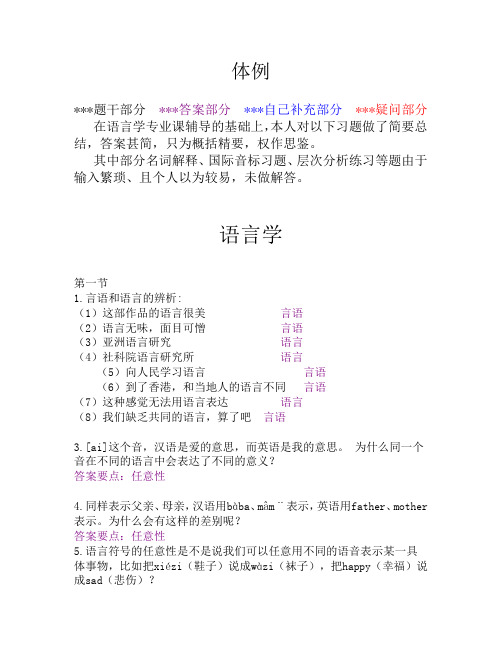
体例***题干部分 ***答案部分***自己补充部分***疑问部分在语言学专业课辅导的基础上,本人对以下习题做了简要总结,答案甚简,只为概括精要,权作思鉴。
其中部分名词解释、国际音标习题、层次分析练习等题由于输入繁琐、且个人以为较易,未做解答。
语言学第一节1.言语和语言的辨析:(1)这部作品的语言很美言语(2)语言无味,面目可憎言语(3)亚洲语言研究语言(4)社科院语言研究所语言(5)向人民学习语言言语(6)到了香港,和当地人的语言不同言语(7)这种感觉无法用语言表达语言(8)我们缺乏共同的语言,算了吧言语3.[ai]这个音,汉语是爱的意思,而英语是我的意思。
为什么同一个音在不同的语言中会表达了不同的意义?答案要点:任意性4.同样表示父亲、母亲,汉语用bàba、mâm¨表示,英语用father、mother 表示。
为什么会有这样的差别呢?答案要点:任意性5.语言符号的任意性是不是说我们可以任意用不同的语音表示某一具体事物,比如把xiézi(鞋子)说成wàzi(袜子),把happy(幸福)说成sad(悲伤)?答案要点:任意性同时注意强制性语言的社会交际功能6、请根据下列句子回答问题。
(1)小明学习计算机。
(2)老陈研究书法。
(3)叔叔修理汽车。
(1)在这三句话中,哪些词的关系是组合关系?它们是以什么句法关系组合的?答案要点:横向组合关系,主谓、述宾(2)在这三句话中,哪些词的关系是聚合关系?它们有些什么共同的特点?答案要点:纵向聚合关系名词可作主语施事……(3)修理一词能否与书法一词组合,试说明理由。
答案要点:词义搭配7、许多语言学的基本概念都涉及组合关系和聚合关系。
请指出下列哪些术语谈及的是组合关系,哪些是聚合关系?元音聚合同义词聚合主语聚合偏正关系组合音位与音位变体聚合动词与它的宾语组合8.每个人说话都是自由的,但不能把我看书说成书看我?答案要点:不符合语法的组合关系(或语义)破坏语言的交际功能9.任何一种语言所包含的句子的数量都是无限的,那么人类为什么能在有限的时间学会掌握语言呢?答案要点:语言的递归性10.某电视台播出了一个新闻,说是有个人养了一只鹦鹉鸟,它不但能向人问好,还能扯着嗓子背诵唐诗《登鹳雀楼》,这是不是说鹦鹉会说话?为什么?答案要点:人类语言和动物语言的本质区别11.人们平时常说,无产阶级和资产阶级没有共同语言,工人有工人的语言,农民有农民的语言。
汉语互动语言学研究发展综览

汉语互动语言学研究发展综览汉语是世界上最广泛使用的语言,也是最受关注的语言之一。
因此,探究如何更好地实现汉语互动的语言学研究受到了极大的关注。
本文就是分析《汉语互动语言学研究发展综览》的研究,总结当前汉语互动语言学的研究状况,发现存在的问题以及提出未来发展方向的相关建议。
首先,汉语互动语言学研究的研究内容主要是关于语用习得与互动视角下的汉语理论。
简单来说,汉语互动语言学研究关注汉语中形式,内容,意义和语用的研究,并提出理论模型和研究方法,以更好地理解汉语的特性和其使用的特点。
目前已经有很多论文和书籍来讨论这一话题,包括《汉语语言学精要:互动视角》,《汉语互动研究:理论与实践》,以及《汉语互动口语学》等。
其次,近年来,汉语互动语言学研究取得了巨大进展。
根据最新的研究报告,近几年来,汉语互动语言学研究的研究内容不断丰富,知识体系不断深入,从基础研究到应用研究,从理论探讨到实践探索,都有重大发展。
比如,大量的论文介绍了汉语互动语言学研究的研究内容,以及各种理论和方法;研究者也利用计算机技术对汉语互动语料进行分析,优化和应用;同时,也有很多研究是关于汉语互动口语学,书面话语,社会话语,语用学,代词的研究的。
第三,尽管近几年来汉语互动语言学研究取得了显著的进步,但也存在一些值得改进的地方。
许多研究者更多的关注的是对汉语的理论的探讨,而没有足够的关注社会、文化等问题的探究,以及对汉语意义的理解。
此外,汉语互动语言学研究还面临着一些技术和社会问题,如多语言数据收集和分析,大规模汉语数据库的建立和开发,以及如何利用计算机自然语言处理技术对汉语互动数据进行有效分析等。
最后,未来,汉语互动语言学研究发展的方向应该是:一是进一步深化基础理论研究,如分析汉语的形式,内容,意义和语用,结合各种学科的理论和方法;二是借助计算机技术,对汉语互动语料进行大规模分析,丰富和改进基础理论,开发新的应用及其在汉语教学和语言治理方面的应用;三是提高汉语互动学研究的关注度,通过参与社会环境,解决社会问题,更好地探究和推理跨文化交流中的汉语现象,实现汉语的真正价值。
语感培养五法

语感培养五法[摘要]培养语感是提高学生语言能力的重要途径之一,培养语感的方法多种多样,基本的有比较法、联系法,想象法,入境法,激情法等,在培养语感的时候,我们还需要注意根据不同的语言作品灵活采用办法。
[关键词]语言学习语感培养方法注意事项[中图分类号]g421 [文献标识码]a [文章编号]1006-5962(2013)03(a)-0166-01我们学习语言,无非就是听、说、读、写,通过在语言环境中听、说、读、写来对语言本身进行思考、体味,从而积淀语感,习得感受语言、运用语言的能力。
以往的经验告诉我们,感受到的语言作品越多,人的语感能力就越强,因此,语感的培养除了要重视教学以外,更要强调在生活中学习,多听、多说,充分利用社会这个大的有益的语言环境,来培养学生的语感。
但就课堂教学来说,听、说、读、写四种方式中,读是最根本的。
读,见于目,出于口,闻于耳,记于脑。
学生可以通过多种形式的读,品美、体味、激情、悟理。
曾国藩在家书中曾说:“李杜韩苏之文,韩欧曾王之文,非高声朗诵则不能得其雄伟之概,非密咏恬吟则不能探其深远之韵。
”由此可见,培养语感最基本的途径是读。
在实际教学中,我们可以采用以下一些基本方法:1.比较法比较、揣摩富有表现力的词语,是培养语感准确性最常见的方法。
通过对词语的替换、增删、变序等方式,可使学生感受课文中语言的精练、细腻、形象等特色,学会准确地运用语言来表情达意。
课文《狼牙山五壮士》中有这样一句话:“五位壮士屹立在狼牙山顶峰”。
在引导体会“屹立”一词时,我采用词语替换方式,把它换成“站立”“挺立”,让学生比较。
学生经过对比、推敲,悟出了作者用词的精妙贴切:“站立”只是一种姿势,“挺立”也不能反映出五壮士的内在精神,惟有“屹立”才准确地勾画出一幅大理石英雄群雕图,表现出他们那种威武不屈、视死如归的英雄气概。
这样,学生的语感就会油然而生。
2.联系法敏锐的语感往往是和对生活的敏锐感受密切联系的。
语言学
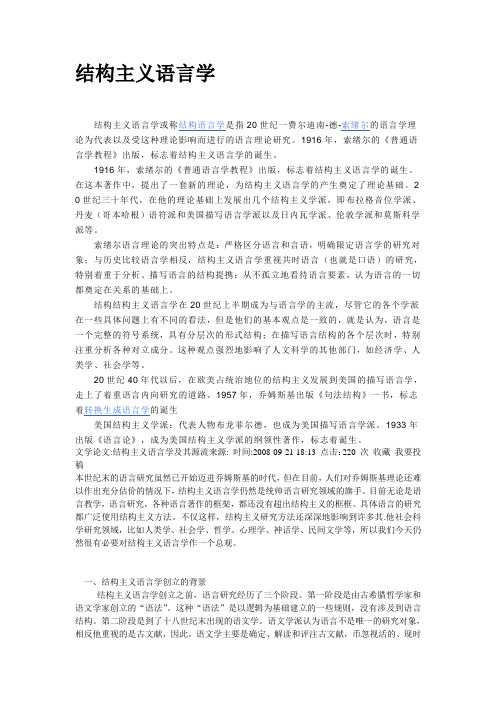
结构主义语言学结构主义语言学或称结构语言学是指20世纪一费尔迪南-德-索绪尔的语言学理论为代表以及受这种理论影响而进行的语言理论研究。
1916年,索绪尔的《普通语言学教程》出版,标志着结构主义语言学的诞生。
1916年,索绪尔的《普通语言学教程》出版,标志着结构主义语言学的诞生。
在这本著作中,提出了一套新的理论,为结构主义语言学的产生奠定了理论基础。
2 0世纪三十年代,在他的理论基础上发展出几个结构主义学派,即布拉格音位学派、丹麦(哥本哈根)语符派和美国描写语言学派以及日内瓦学派、伦敦学派和莫斯科学派等。
索绪尔语言理论的突出特点是:严格区分语言和言语,明确限定语言学的研究对象;与历史比较语言学相反,结构主义语言学重视共时语言(也就是口语)的研究,特别着重于分析、描写语言的结构提携;从不孤立地看待语言要素,认为语言的一切都奠定在关系的基础上。
结构结构主义语言学在20世纪上半期成为与语言学的主流,尽管它的各个学派在一些具体问题上有不同的看法,但是他们的基本观点是一致的,就是认为,语言是一个完整的符号系统,具有分层次的形式结构;在描写语言结构的各个层次时,特别注重分析各种对立成分。
这种观点强烈地影响了人文科学的其他部门,如经济学、人类学、社会学等。
20世纪40年代以后,在欧美占统治地位的结构主义发展到美国的描写语言学,走上了着重语言内向研究的道路。
1957年,乔姆斯基出版《句法结构》一书,标志着转换生成语言学的诞生美国结构主义学派:代表人物布龙菲尔德,也成为美国描写语言学派。
1933年出版《语言论》,成为美国结构主义学派的纲领性著作,标志着诞生。
文学论文:结构主义语言学及其源流来源: 时间:2008-09-21 18:13 点击:220 次收藏我要投稿本世纪末的语言研究虽然已开始迈进乔姆斯基的时代,但在目前,人们对乔姆斯基理论还难以作出充分估价的情况下,结构主义语言学仍然是统帅语言研究领域的旗手。
目前无论是语言教学,语言研究,各种语言著作的框架,都还没有超出结构主义的框框。
幼儿园语言领域教育精要读后感

幼儿园语言领域教育精要读后感如何上好一节语言课是我一直有所困惑的事情,为了提升自己的教育教学能力,最近我仔细的阅读了《幼儿园语言领域教育精要》,给我的感受很深,使我认识到自己平时在语言教学中的不足之处,使我认识到自己在语言教学中有很多地方需要改进和提高,对我的帮助很大。
语言是逻辑的基础,不同的语言有着不同的思维方式,多学一种语言思维就复杂一倍。
因此语言在教育中是非常重要的。
教师必须丰富幼儿的生活,为幼儿创造良好的语言环境;必须掌握幼儿学习语言的规律,有计划地进行培养和训练;创造机会让幼儿多听、多看、多说、多练,培养幼儿良好的语言习惯和语言兴趣。
这样,幼儿的语言一定会得到健康、顺利地发展。
书上通过目标内容、教学方法、活动设计、环境材料、领域渗透、日常生活、发展评价七个方面的内容向我们介绍了教师应该如的对幼儿进行良好的语言教育。
由于书上介绍的范围很广,我就专门针对我读了该书的教学方法和活动设计两方面内容,来说说我自己的想法和感受。
书上指出语言教育可细分为:谈话活动、讲述活动、文学作品欣赏活动、早期阅读活动、听说游戏活动。
谈话活动和讲述活动主要是培养幼儿说的能力;听说游戏活动则是培养幼儿倾听的能力;早期阅读活动主要是让幼儿从口头语言向书面语言过渡;而文学作品欣赏活动主要目的是陶冶幼儿的情操,启迪幼儿的智慧,其次再发展幼儿的语言。
语言教学就是给幼儿讲故事、念儿歌并让他们学会讲这些故事和儿歌。
其实这是一种不正确的语言教育教学理念,幼儿的语言是靠在不断的听、说过程中把自己原有的经验转化为新的知识经验。
因此我认为为了快速提高幼儿的语言能力,许多老师应该对正确的开展讲述活动、谈话活动、听说游戏活动以及早期阅读活动花些心思。
孩子只有真正学会了说话,把自己的愿望用正确的语句表达出来,才自由地和人交往,同时也才能更好地接受成人传授的知识和经验。
在教育工作中,我们应有目的地丰富幼儿生活内容,增长幼儿知识,开拓幼儿视野,培养幼儿多方面的兴趣。
《幼儿园语言领域教育精要》读后感

《幼儿园语言领域教育精要》读后感幼儿园语言领域教育精要读后感
《幼儿园语言领域教育精要》这本书让我对幼儿园语言教育的
重要性有了更深刻的认识。
本书从幼儿语言发展的理论背景开始,
系统地介绍了幼儿园语言领域的教育内容和方法。
书中强调了语言对幼儿发展的重要性。
语言是一种交流工具,
不仅可以帮助幼儿表达自己的想法和情感,还可以促进他们的认知
和社交能力的发展。
通过在幼儿园营造丰富的语言环境,引导幼儿
参与各种有意义的语言活动,可以激发他们对语言的兴趣,培养他
们的语言能力。
在书中,我还了解到了幼儿园语言领域的各个重要方面。
语音、听觉、词汇、句法、语用等内容都应包括在幼儿园语言教育中。
通
过有针对性的活动和练,可以帮助幼儿掌握正确的发音、听力技巧,丰富词汇量,提高语法理解和语言运用的能力。
除了教育内容,书中还介绍了一些有效的教育方法。
例如,培养幼儿的阅读兴趣和惯,可以通过阅读故事书、设置图书角等方式进行;通过角色扮演、情景模拟等活动,可以帮助幼儿提高语言运用的能力;使用多样化的教具和游戏,可以激发幼儿的研究兴趣和动手能力。
阅读完《幼儿园语言领域教育精要》,我深刻认识到了幼儿园语言教育的重要性和方法的多样性。
作为一名教育工作者,我们应该不断研究和探索,为幼儿提供更好的语言教育环境和机会。
阅读这本书让我受益匪浅,我将会在实践中运用书中的知识和方法,不断改进自己的教学方式,更好地帮助幼儿掌握语言,促进他们全面发展。
总之,我强烈推荐《幼儿园语言领域教育精要》这本书给所有从事幼儿教育的人士,相信它会对他们的教学工作有很大的帮助和启发。
语言学概论(完整版)前半部分.

【语言学概论备考精要-上半部分】音质是一个声音区别于其他声音的基本特色。
一般语汇可以分为:新造词、古语词、方言词、外来词。
外来词(借词)的三种方式:纯粹音译、半音译半意译、音译兼意译。
专用语汇包括:科技术语、行业语。
#科技术语同时也是专有名词。
奥林匹克属于:单纯词、音译词、专有名词、多音节词。
狼吞虎咽是惯用语。
成语中的口头用语包括:七手八脚、欢天喜地、过河拆桥等。
科学、电话不属于外来词。
浪漫、可口可乐、幽默、香波属于音译兼意译的外来词。
徘徊属于连绵词、单纯词。
语汇构词中的复合构词分为:陈述式、偏正式、支配式、并列式。
#广义的构型包括语汇构词中的附加构词,如-tion、-ful、-ly。
词法手段包括:词形变化、词的轻重音、词的重叠。
词形变化包括:附加、曲折、异根、零形式。
词的轻重音包括重音移动和轻声,具有区别词性或区别意义的作用。
句法手段包括:虚词、语类选择、语序、语调。
俄语中房子、房间、楼房分别属于阳性、中性、阴性。
◆瑞士语言学家索绪尔的《普通语言学教程》(1916年)开创了20世纪现代语言学的新局面。
最早的比较全面系统地阐述“语言”的一般理论的著作是洪堡特(德)的《论人类语言结构的差异及其对人类精神发展的影响》。
传统语言学一般泛指20世纪以前的语言学,特别是指索绪尔开创的结构主义语言学以前的语言学。
语言学研究的角度包括语言的本体、社会功能、与思维之间的关系。
判断两种话是不同语言还是同一种语言的不同方言,不能单凭“相互理解程度”来划分,而应该主要依据共同的历史文化传统和由此产生的民族认同感,再参考社会政治因素来处理。
◆四呼中,齐齿呼、合口呼、撮口呼的韵头或韵腹分别是[i]、[u]、[y],除此之外,都是开口呼。
语音中的浊辅音是乐音和噪音的混合体。
决定声音音质的因素有:发音体、发音方法、共鸣器的形状。
非音质音位包括调位(声调)、重位(轻重音)、时位(长短音)。
语调的句重音分为两种:节律重音(语法重音)、强调重音(逻辑重音)。
- 1、下载文档前请自行甄别文档内容的完整性,平台不提供额外的编辑、内容补充、找答案等附加服务。
- 2、"仅部分预览"的文档,不可在线预览部分如存在完整性等问题,可反馈申请退款(可完整预览的文档不适用该条件!)。
- 3、如文档侵犯您的权益,请联系客服反馈,我们会尽快为您处理(人工客服工作时间:9:00-18:30)。
PART ONE 第一部分Language from within 语言系统Chapter One: Introduction to Linguistics第一章导入一. 核心提示二. 概念定义langue vs. parole…Competence vs. p erformance….三、理解简答1. What is language?什么是语言?2. What functions does language have?语言有那些功能?3. What are features of human language specified by C. Hockett?霍基特阐明了人类语言的哪些特征?4. What is linguistics?什么是语言学?5. What are the major branches of linguistics? What does each of them study?语言学的主要分支学科有哪些?其研究内容是什么?6. Why is it that linguistics is scientific study of language?为什么说语言学是一门科学?7. Of the two major media of communication, speech and writing, which one is primary?在两种主要交际媒介中,即口头语和书面语,哪一种是第一性的?8. What is the difference between langue and parole?语言和言语之间的区别是什么?9. What is the distinction between the competence and the performance?语言能力和言语行为有什么差异?10. How is Sanussure’s distinction between langue and parole similar to Chomsky’s distinction between competence and performance?索绪尔对语言和言语的区分与乔姆斯基对语言能力与语言运用的区分有什么相似之处?11. What makes modern linguistics different from traditional grammar?现代语言学与传统语法的不同之处在哪里?12. Is modern linguistics mainly synchronic or diachronic?现代语言学是主要是共时性的,还是历时性的?13. Does the traffic light system have duality? Can you explain by drawing a simple graph?交通灯系统有二层性吗?14. How do you comment on dog’s barking?你如何看待狗吠?15. What is the recursive nature of language?何谓语言的递归性?16. Do body language and facial expression share or lack the distinctive properties of human language?身体语言和面部表情具有人类语言的哪些独特特征?17. Can you judge the synchronic or diachronic orientation just from the titles?你能仅从书名判断著作的研究倾向是历时或共时的吗?18. Why is the distinction between competence and performance important in linguistics?为什么语言能力和语言运用的区分在语言学中很重要?19. How do you understand arbitrariness in a sentence?如何理解语句顺序的任意性?20. Do you think that onomatopoeia indicates a non-arbitrary relationship between form and meaning?你是否认为拟声词表明了形式与意义之间非任意的关系?Chapter Two: Speech Sounds 第二章:语音一. 核心提示二. 概念定义Phonetics……Cardinal Vowels……三、理解简答1. How do the three branches of phonetics contribute to the study of speech sounds?语音学的三个分支对语音学的研究有什么贡献?2. . How do phonetics and phonology differ in their focus of study?语音学和音位学的研究重心有何不同?3. Where are the resonating cavities of a human being contained?人类的发音的共鸣腔位于什么地方?4. What is the function of the nasal cavity? How does it perform this function?鼻腔的作用是什么?它如何发挥作用?5. What are the various parts in the oral cavity which are involved in the production of speech sounds?口腔中发音所涉及的各部分有哪些?6. How broad transcription and narrow transcription differ from each other? Provide with examples.举例说明宽式音标和严式音标的区别?7. How are the English consonants classified?英语的辅音如何分类?8. How are the English vowels classified?英语的元音如何分类?9. What is the phonetic symbol for each of the sound descriptions offered?所给语音描述的语音符号是什么?10. What are the phonetic features of each of the sounds given?所给语音符号的语音特征是什么?11.Transcribe the following sentences into normal orthography.写出下列音标代表的英语句子12. Who do you think will be more interested in the difference between, say, [l] and [l-], [p] and [ph], a phonetician or a phonologist? and Why?语音学家和音位学家,哪一个更关心清晰音[l]和模糊音[l]以及[p]和[ph]的区别?为什么?13. What is free variation?什么是自由变异14. What is assimilation?什么是同化现象?15.What are distinctive features?什么是区别特征?16. What is a minimal pair and what is a minimal set? Why is it important to identify the minimal set in a language?什么是最小对立对?什么是最小对立组?为什么区别最小对立组在一种语言中非常重要?17.Can you answer the following questions concerning English dialects?能否回答下列关于英语方言问题?18. What is complementary distribution?什么是互补分布?19. What are the definitions of, with examples, the sequential rule, the assimilation rule, and the deletion rule?举例说明什么是序列规则?什么是同化规则?什么是省略规则?Chapter Three: Lexicology第三章语词一、核心提示二、概念定义Morpheme….Loanshift….三、理解简答1. What does morphology study?形态学研究的是什么?2. What are, with examples, the various types of morpheme used in English?英语中有哪些所用语素?举例子说明。
3. What are the main inflectional affixes in English? What grammatical meaning do they convey?英语中有哪些主要屈折词缀?它们表达什么语法意义?4. Can you find out the meaning of the following roots in English and give two or three words that contain each of them?能否指出下列英语词根的含义并分别举出两三个包含这些词根的单词?5. What are the morphological rules that govern the use of the given derivational affixes?所给屈折词缀的用法的形态学规则是哪些?6. What is collocation?什么是搭配?7. What are the main features of the English compounds?英语复合词的主要特征是什么?8. How to explain the formation and meaning of the following compounds?如何解释所给复合词的构成及意思?9. How to understand word/lexicon/lexeme/vocabulary respectively?如何理解字词/词语/义素/词汇量?10. Can you give the percentage of function words in this paragraph?能否给出这段话中功能词的百分比?11.Determine the original term from which the following words were back – formed.根据下列的逆构词确定其最初的形式。
